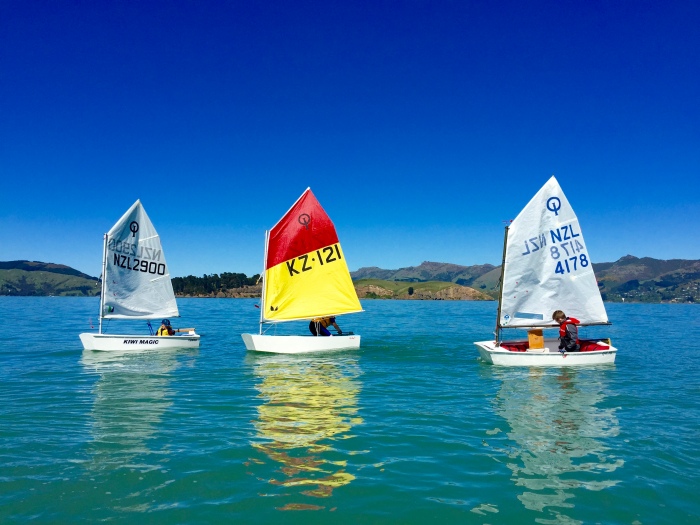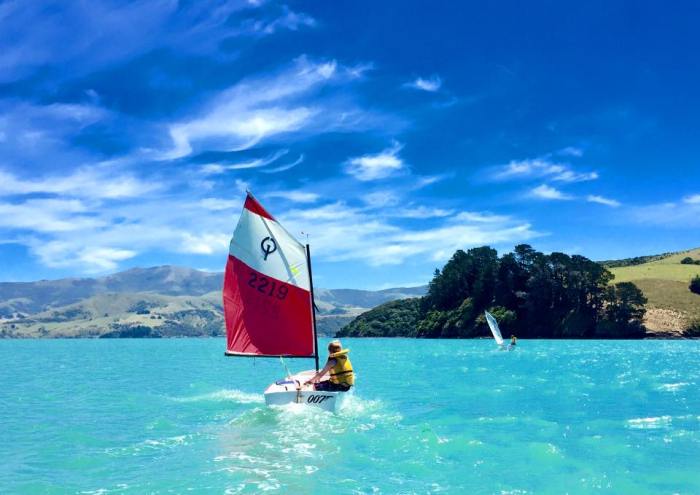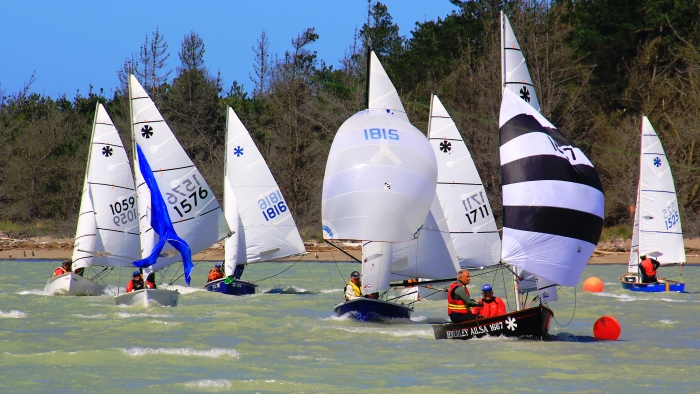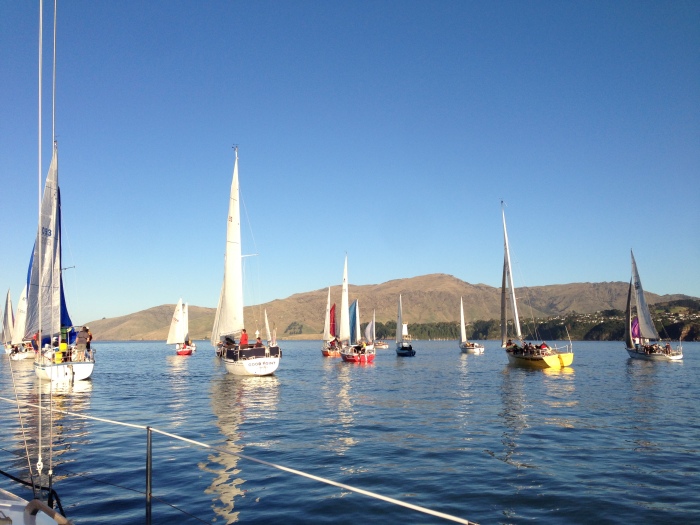Being a small island nation, New Zealanders have a natural affinity with the water. Here in Canterbury we are particularly lucky to have a variety of different sailing locations to suit everyone’s tastes.
If you are a fan of the water, and are wanting to make new friends, challenge yourself and try something new, then sailing is an excellent option. Here are some tips to steer you in the right direction.

1. Is Sailing For me?
Yachting New Zealand’s by-line is that ‘Sailing is a Sport for Life’. Whether you are young or old, keen to race or you’d rather cruise, on a limited budget or have lots of money to spend, there is a boat to suit you. You don’t have to be a competitive sailor to enjoy being out on the water. There are many options to choose from, and it pays to start doing some research in advance so you can focus on what suits you best before you start spending any money.
Children can start sailing on their own from as young as nine or ten years old, with their weight (being heavy enough) and confidence being the main limiting factors. They would usually start sailing in an Optimist or a Firebug, and then progress from there in to a P Class, Starling and on to many other options from there.
Adults can learn to sail in a dinghy like a Laser, or perhaps as part of a group on a larger trailer yacht or keelboat. You can check out some of the many different types of yachts available in Canterbury on the CYA Website.
Sailing is also a great activity for families. Two person dinghies like Sunbursts are a popular choice for a parent and child to sail together. Trailer yachts and keelers can easily accommodate four people or more, and take you on longer passages, overnight trips and to cool places that would otherwise be difficult to get to.
The sailing season runs from September through to April each year with some clubs also offering a winter sailing programme. A reasonable level of fitness is required, and it is recommended that you are a competent swimmer.

2. How much is it going to Cost?
Many clubs have boats available for hire for beginners participating in learn to sail programmes. Every club is different, but a course of lessons start from around $200 per person.
Once you have completed your lessons, if you are keen to continue then you might want to consider buying a boat. A basic wooden Optimist on a launching trolley for the kids starts from around $500, through to anywhere around $4,000 for a full-on racing model.
A Laser for an adult can cost anywhere from $2,000 through to $13,000 for a brand new model. Trailer yachts start at around $5,000 for something basic and then with keelers the sky is the limit.
Trademe is a good place to start shopping around. Remember to check if the boat comes with a road trailer, and consider where you are going to store it – some clubs offer boat storage options for an extra cost. If you buy a keeler, then you will need a mooring, and with any luck we will soon have a new marina in Lyttelton to keep boats as well.
If you would prefer not to buy your own boat, you can also crew for other people. Bigger yachts are always on the look out for keen crew members to help sail their boats.
Once you have bought a boat you might consider joining a yacht club. Each club has different membership fees for juniors, adults and families ranging from anywhere between $120 – $350 for the year.
Boats do require maintenance, and this varies depending on whether you buy wooden or fibreglass, the size of your boat, the age and condition of your sails, and how you sail it. A general rule of thumb is to budget 10% of the value of the boat each year for maintenance.
 Photo Credit: Ron Finch
Photo Credit: Ron Finch
3. Learning to Sail
There are lots of different ways of learning to sail. All the Canterbury clubs offer a variety of programmes throughout the summer for juniors, youth, adults, and classes specifically for women. If you have a friend with a boat, ask them to take you out for a sail to get a taste of what it might be like. Clubs sometimes offer “Have a Go” days as well.
Taking a course with a qualified instructor is always a good place to start. Often it is much easier and less stressful than being taught by your partner or friends.
You can choose to learn on a dinghy or on a larger boat. Learning in a dinghy means you learn all the skills of handling a boat on your own. This can then easily be transferred to larger boats. When learning on a bigger boat with other crew, you tend to only learn one position at a time, and it can be a little harder to get a feel for how it all comes together.
You can expect to learn things like:
- Safety & hazards on board – Things like slippery decks, fingers near winches, ropes & sails, the boom, sunburn, hypothermia, losing things over the side.
- Safety equipment, what to take, where to stow it and how to use it. The main ones are life jackets, fire extinguishers, anchor & warp, signalling devices, secondary means of propulsion, bailer, forms of communication – phone, VHF radio
- Clothing – wet weather gear, life jackets, gloves, hat and what not to wear.
- Weather – marine forecasts, reading the wind
- Parts of the boat/rig
- Sailing definitions and point of sail (upwind, downwind, tacking, gybing, windward, reward, luffing, bearing away, reaching, running etc)
- Knots & handling lines
- Using winches (if on a bigger boat)
- The physics of sailing – how a sail works, how the keel and rudder work
- How to use the motor – if on a boat with a motor, starting, stopping, fuel, water, air, gear lever. Manoeuvring under power. Picking up a mooring, coming alongside a berth.
- Crew positions – if there is more than one of you on board – skipper, mainsheet, trimmer, tailer, keyboards, mast & bow.
- Rigging and de-rigging the boat, hoisting the sails.
- How to sail the boat, tacking & gybing & trimming the sails, changing sails, reefing, heaving to
- Collision avoidance rules – COLREGS
- Man Overboard
- Using a VHF radio
- Anchoring
- Rowing & towing a dinghy, using an outboard engine
- Navigation, reading charts, using GPS, reading a compass
- Planning a voyage
- Launching & retrieving trailer boats
Once you have mastered the basics, then you can go on to learn about racing rules and then participate in novice races, which is a great way to practice and improve your skills.
Coastguard Boating Education offer a variety of excellent theory based courses for people wanting to learn about safety, navigation, seamanship, weather and much more. Start with Day Skipper and work your way up.
 Photo Credit: Jeff Morrison
Photo Credit: Jeff Morrison
4. Where Do I Go?
In the Canterbury Region we have 10 yacht clubs. Clubs offer a supportive environment to network with other sailors. Each has its own atmosphere specialities and different programmes on offer. Yacht clubs provide access to the water, run racing and cruising programmes throughout the season, provide rescue boats on the water along with learn to sail classes, coaching for experienced sailors, and social programmes as well. All the clubs welcome visitors and new members.

Stewarts Gully Sailing Club – is a family orientated dinghy sailing club based on the sheltered waters of the Waimakariri River. They offer both adult and children’s learn to sail classes.
The Waimakariri Sailing and Power Boat Club – located on the lower reaches of the Waimakariri River also caters for dinghy sailors, juniors, adults and families. They have club yachts available for hire, and offer learn to sail lessons.
Pleasant Point Yacht Club -Located on the Estuary near New Brighton, this club is a friendly, family club offering sailing for dinghies and trailer yachts. Learn to sail courses are available, with yachts and lifejackets supplied… or if you have your own yacht and need some tuition, bring it down to Pleasant Point and they will help you get out on the water.
Mount Pleasant Yacht Club – In Ferrymead has an active Learn to Sail programme for both Juniors and Adults, a Coaching programme for advanced learners, and Club racing most weekends during the summer.
Christchurch Yacht Club – in Redcliffs, welcomes new members and families, with learn-to-sail and junior coaching programmes available throughout the season. They have access to the water at all levels of the tide and also have moorings and a slipway for keelboats.
Naval Point Club Lyttelton – This is a large club catering from dinghies, trailer yachts and keelboats. They run a variety of learn to sail courses throughout the season, with racing every weekend and Wednesday nights through the summer. Naval Point offers sailing for disabled people in specially designed boats and they also have a keen cruising fleet and the keelboats are always on the look out for extra crew members.
Charteris Bay Yacht Club – Located in a sheltered bay on the Southern side of Lyttelton Harbour, Charteris Bay caters for dinghy sailors and offers junior and adult learn to sail classes.
Pigeon Bay Boating Club – About an hour and a half drive from Christchurch, Pigeon Bay offers all tide sailing on flat water. They provide club boats for people wanting to learn to sail. There is a campground nearby if you want to stay all weekend.
Akaroa Yacht Club – This club has a youth/dinghy sailing programme with club boats available to hire, and keelboat racing and cruising events.
Timaru Yacht and Power Boat Club – Offers opportunities to share and improve your boating skills whether your interests are in yacht racing, family boating, cruising or joining in with our junior sailing program. They cater for dinghies and trailer yachts.
Check out the club websites to see if they offer the kind of sailing that you are interested in. Then either contact the Commodore, or head along on a sailing day to get a feel for the club atmosphere. Sailors are a friendly bunch and they love to help new people get involved in the sport they are so passionate about.
Commercial providers include:
Learn 2 Sail – on keelboats in Lyttelton Harbour
Kore Kiwi Sailing – dinghies on Lake Pegasus or Lake Rua

5. What Shall I Wear?
Even on hot days, the Easterly breeze can be cold, so being kitted out in the appropriate gear will make your day much more enjoyable.
If you are sailing a dinghy you will want to wear a wetsuit. A windbreaker jacket over the top also helps keep you warm, and then a life jacket over the top of that. Wetsuit booties or something similar on your feet makes launching and retrieving your boat much easier.
Wear sailing gloves to protect your hands when you are handling lines. A cap and sunglasses on a lanyard along with lots of sunscreen are also essential.
Bring a towel for a hot shower, and a change of clothes to wear in the wardroom afterwards.
If you are sailing on a trailer yacht or a keeler, you usually won’t require a wetsuit. However if it is cold, a decent wet weather jacket, and pants will make your day much more enjoyable. Non-slip, non-marking footwear is also important. While most boats carry spare life-jackets, it is best to bring your own to ensure a good fit. Wear gloves, a hat, sunglasses and sunscreen.
6. Will I get Seasick?
Most of the club sailing takes place on sheltered water, and in dinghies you are usually too busy to get sick. But if you are heading beyond the shelter of the harbour and are prone to seasickness there are lots of different options and medications available. Try to keep hydrated, have a good breakfast, and keep snacking throughout the day.

7. Other Options for Getting Involved
Yacht clubs are always on the lookout for volunteers and they offer free training for people who are keen to assist. There are many different options both on and off the water including driving the rescue boats, race management, judging, coaching and helping out in the office or in the cafe/bar.
8. Common Boating Terminology
Sometimes sailors seem to be speaking a different language. Here are a few of the more commonly used words that are useful to know.
- Bow – Front of the Boat
- Stern – Back of the Boat
- Rudder & Tiller – Steers the boat
- Mainsheet – rope that controls the large sail
- Headsail or Genoa/Jib Sheet – rope that controls the headsail
- Halyard – rope that pulls the sails up the mast
- Spinnaker/Kite – big balloon like sail used for going downwind
- Tacking – changing direction in to the wind
- Gybing – changing direction with the wind behind you
- Port (red) – Left
- Starboard (green) – Right
- Painter – rope at the front for towing the boat

9. Safety
- Always check the marine forecast before heading out on the water.
- Tell someone where you are going and when you are likely to be back.
- If you are sailing alone (not in an organised race or activity) take some form of communication with you. A cellphone is good, but a VHF radio is even better – tuned in to channel 16. Carry them in a dry-bag and learn how to use the VHF correctly by getting your radio operator certificate.
- Dinghies should carry a painter (tow rope at the front) a bailer and a paddle.
- Always wear a life jacket.
 Photo credit: Ron Finch
Photo credit: Ron Finch
10. Other Tips
The prevailing wind in Canterbury is an Easterly sea breeze. As the land heats up during the day, the air rises, drawing cooler air from over the ocean inwards. The wind gradually builds during the day and can be much stronger in the afternoon. It is a great constant breeze to sail in.
The Nor-Wester can be very strong, blustery and challenging, a Nor-Wester is usually followed by a Southerly. The Southerly front can hit very quickly, with strong winds producing sometimes dangerous conditions. Always check the marine weather forecast before heading out.
There are hundreds of sailing books available to provide further inspiration, advice and knowledge. Many people have written books about their adventures at sea and these make for a great read.
You can also read blogs about sailing. There are a number of online groups such as Women Who Sail New Zealand, or Sailing and Cruising where you can network online with other sailors, pose questions and share advice.
If you are invited to sail on someones boat, be upfront about what kind of experience (if any) you have had. Bring your own lifejacket, and warm clothes in a small bag. It pays to keep your phone or anything precious in a dry bag. To increase your chances of being asked back, bring along some food or drinks to share with the rest of the crew after sailing, and offer to help out with any maintenance. Skippers are sometimes more interested in your ability to fit in with the rest of the crew than your sailing skills.
Don’t be daunted by the word ‘Yacht Club’. Everyone is very down to earth, share a common interest for the sea and enjoy welcoming to new people. You will make new friends, learn new skills and have some incredible adventures once you start sailing. With spring on our doorstep, now is the perfect time to start researching the options.
Finally, you can ‘Like’ The Canterbury Yachting Association Facebook page to hear more about what is going on with sailing in Canterbury. Check out our website to learn more about the clubs and class associations in the area. We look forward to welcoming you to one of our clubs and helping you get out on the water!








That’s a great piece! I would think non-sailors would find it very useful, and would definitely,want to start sailing after that. I would say that for me, it was really useful to have done several dinghy sailing courses first, before I learnt to sail a big yacht. Although they are obviously different creatures, knowing about the points of sail, where the wind is, basic ‘rules of the road’, parts of the boat, steering etc was incredibly useful when I boarded a 40 footer for the first time. Your photos are fantastic!
LikeLiked by 2 people
Thanks so much for the great feedback. 🙂
LikeLike
same here… spent my very first week sailing on a yacht, but the “deeper” understanding of how it all works came with dinghy sailing.
Will write a separate comment later on how it all started for me and on my kids first sailing experience.
Fantastic article, Viki!!
LikeLiked by 2 people
Thanks Hubert and I would love to hear your first experiences too! 🙂
LikeLike
Well written Vicki, I would like to link this to my website, very useful for newbies, cant we get you to join us to teach the women only adult lessons at learn2sail.co.nz? Just a couple a year? !!
LikeLiked by 1 person
Lol – thanks Dudley! I’d be honoured for you to link to your website. I will remove the first couple of paragraphs shortly so it flows a bit more nicely. Sadly I haven’t got the patience to be a teacher! However I am happy to be a sailing mentor to any women who graduate from learning the basics with you guys – will chat further 🙂
LikeLike
Very indepth!
LikeLiked by 1 person
Hi, Viki! Loved your article immensely and all the wonderful information you provided. I’ve enjoyed being on boats since I was very young, but have never really learned to sail properly. It’s on my bucket list. I’m looking forward to the day when I will know what to do instinctively on a boat. Until then I will keep reading and learning as much as I can. You are one of my go to blogs for all things sailing. Thanks so much!
LikeLiked by 1 person
Thanks Diane! I look forward to hearing about your sailing lessons one day! I am sure you will be a natural 🙂
LikeLike
grew up on a farm in Northern Bavaria, and the word “sailing” was not part of our active linguistic usage. With a girlfriend being from Flensburg (located directly at the Baltic Sea) I got my first taste of open water, and one day it just happened: looking at the water was not enough, wanted to be on it… started with an introductory course on a yacht, and after that one week I did not have a clue what it was all about. Only a year later did I understand how wind, tiller, sheets and so on work together – tought during a dinghy sailing course 😉 Since then it’s been sailing on all kind of boats for me, and I would not want to miss this part of my life (and my folks and friends back in Northern Bavaria still keep wondering what has become of me).
I love the agility of dinghies as well as the safety of yachts, and have now fallen for the Classe Mini….. 😉
I am sure you covered all the relevant topics, great stuff as usual. And for sailing I believe one brief sentence is more important than reading and talking and researching: just do it.
Apologies for this lengthy reply, will keep it lots shorter next time 😉
LikeLiked by 1 person
Fantastic thanks Hubert! I think “Just Do It” sums it all up very nicely too!
LikeLike
Wonderful post! As a person learning to sail and trying to purchase this is definitely a great resource, and a must read for a newbie! Thanks so much!
LikeLiked by 1 person
Great post , Should work well for our Clubs.
LikeLiked by 1 person
Thanks Lindsay! Just let me know if you want me to modify your paragraph. Cheers Viki 🙂
LikeLike
This is a great introduction and encouragement to start up in sailing! It’s great to have local information, making it especially relevant to NZers and Cantabrians. I’d love to see other regional associations use this very post, adapting it to their local clubs and conditions. I suggest you forward this idea to Yachting NZ!
LikeLike
Thanks Heather!
LikeLike